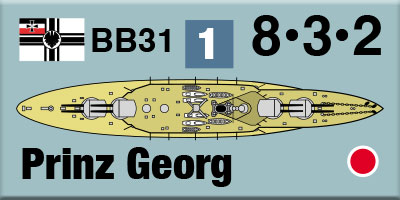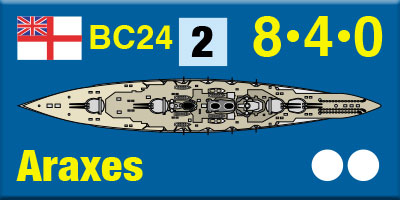| Risk Fleet
Publisher’s Preview
By Mike Bennighof, Ph.D.
July 2024
 We’re supporting Great War at Sea: Jutland’s Second Edition with both new expansions, and matching new editions of previous books. Probably my favorite of those is Risk Fleet (formerly known as High Seas Fleet Third Edition - Risk Fleet is a thoroughly re-made new version of the old book). The book turned out to be exactly what I’d hoped, and now we have the opportunity to make it even better. We’re supporting Great War at Sea: Jutland’s Second Edition with both new expansions, and matching new editions of previous books. Probably my favorite of those is Risk Fleet (formerly known as High Seas Fleet Third Edition - Risk Fleet is a thoroughly re-made new version of the old book). The book turned out to be exactly what I’d hoped, and now we have the opportunity to make it even better.
The book is based on a single historical premise, and a question based off that premise. First, that the so-called “Dreadnought Race” before the First World War wasn’t much of a race, with Germany never employing her full industrial and financial capacity due to political concerns (some foreign, but mostly domestic). And second, the question of how a more powerful fleet might have been used during wartime.
Essays look at those issues, focused on the German side of the equation: politics, finance and ship design, as well as the new ships provided in the book’s counter mix. I probably could have filled the book just with essays, but to give the people what they want you have to strike a balance.

The big change comes in the set of playing pieces. The book includes 70 “long” ship pieces, with the extra ships that Imperial Germany could have built, given a greater commitment to the High Seas Fleet, and some for the British Grand Fleet, as there surely would have been a response. In the old High Seas Fleet book, the set also included replacements for ships with ratings that I’d re-considered over time (all of them armored cruisers). But those appear in their new form in other Second Edition items, like the new edition of Cruiser Warfare and Golden Journal No. 57: Coast Defenders. That lets us replace them with 22 new pieces. So we did.
All of the ships receive new artwork. High Seas Fleet was the first naval game we printed with die-cut and silky-smooth pieces, and this is where we learned that our old ship art was not up to the standard of modern printing. We get very crisp resolution and very rich colors, and to fully use that capability, we need great art. Features that would have turned into gray mud are now crisp and visible.

The Germans are the focus, and so they receive three complete new classes of battleship: the 1904 semi-dreadnought, the 1905 small dreadnought, and the 1912 dreadnought with 13.8-inch guns. Three classes of dreadnoughts also pick up a fifth member, while the Baden class of super-dreadnoughts is repeated for another year with four new units. And Winston Churchill’s alarmist fantasy comes to life, with two Turkish dreadnoughts built in England sailed across the North Sea and presented to the Germans.
For Risk Fleet, the High Seas Fleet gets the addional battle cruisers of each class, as in the prior version, and also three new classes: the alternative layout of von der Tann with single-gun turrets, the alternative to Seydlitz with all of her guns mounted along the centerline, and the up-gunned proposal for Derfflinger with five rather than four turrets.

We have the five additional units authorized for the Blücher class (those authorizations would be used to build the High Seas Fleet’s first five battle cruisers instead). For Risk Fleet, we add the 1904 armored cruiser (the cruiser equivalent of the 1904 semi-dreadnought) proposed and even sketched by Kaiser Wilhelm II himself. The Kaiser’s cruiser as tweaked by the naval design staff is actually a rather forward-looking ship, with the speed to run down enemy armored cruisers and the heavy guns to destroy them.
The British get a limited response: the fourth member of each of their first two classes of dreadnoughts (deleted as a cost-saving measure) is restored, along with some additional battleships and battle cruisers that were discussed but never actually funded.

In Risk Fleet, we also fulfill Sir John Jellicoe’s desire to purchase or lease the four powerful Japanese battle cruisers of the Kongo class. They appear here in British colors, and they are a considerable accretion of strength (which is good, considering all of those new German battle cruisers we added to the mix).
And they also get a pair of designs considered by the Admiralty, but ultimately rejected in favor of more conservative approaches. We have Sir Philip Watts’ design for a modified Indomitable-class battle cruiser with all of her heavy guns mounted along the centerline, and also the proposal to add a fifth turret to the Lion battle cruiser design. That was rejected due to the added cost of the ship, and so we’ve provided alternative versions of Australia and New Zealand built to this scheme, since the Admiralty was building these ships on someone else’s farthing.

To support all of those new heavy ships, the Germans also add a half-dozen light cruisers, additional members of classes that really existed. The High Seas Fleet had a shortage of cruisers, and adding more heavy ships would only make that worse.
To play with all of those ships, we have 36 scenarios, grouped by theme. They draw on Jutland, and only Jutland, for other pieces and for the map. Some are new to Risk Fleet, but most are revised versions of those we had the first time around - not only to bring them up to Second Edition rules standard, but to add all of those shiny new ships to the story.

Unlike most of our expansions, the scenarios aren’t constructed to tell an alternative-history story. Instead, the book looks at different phases of the High Seas Fleet’s growth, and how war might have been more or less likely and how it might have been fought. The book is about evenly split between battle scenarios and operational scenarios. We finally make use of the Faroe Islands up there in the top left of the Jutland map, ignored since we published the game.
Scenarios range in size from small to ultra-large, with Jutland-style battles featuring the augmented fleets of both sides. We look at a 1908 war, with the High Seas Fleet built around its projected but never built semi-dreadnoughts and small dreadnoughts, and a 1912 conflict where fast cruisers take a major role. At the other end of the scale, for the 1916 scenarios the Germans can send almost as many ships with 15-inch and 13.5/13.8-inch guns to sea as the Royal Navy (in the actual Battle of Jutland, they had none against 22 for the British).

A long time ago, wargames were advertised as “paper time machines.” I think that’s greatly overstating things, but every now and then you actually can use one to test out a historical thesis. I like the way we’ve done so with Risk Fleet, and if you’re keen on the historical angle, I think you will too. And if the game’s the thing, then this time the Kaiser actually has a chance.
You can order Risk Fleet right here.
Beyond Jutland
Risk Fleet
Journal No. 38: Alternative Dreadnoughts
Retail Price: $54.98
Package Price: $45.00
Gold Club Price: $36.00
You can journey Beyond Jutland right here.
Sign up for our newsletter right here. Your info will never be sold or transferred; we'll just use it to update you on new games and new offers.
Mike Bennighof is president of Avalanche Press and holds a doctorate in history from Emory University. A Fulbright Scholar and NASA Journalist in Space finalist, he has published a great many books, games and articles on historical subjects; people are saying that some of them are actually good.
He lives in Birmingham, Alabama with his wife, three children, and his new puppy. His Iron Dog, Leopold, could swim very well.
Want to keep Daily Content free of third-party ads? You can send us some love (and cash) through this link right here.
|
